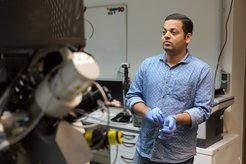Jagannath Jena receives summa cum laude
Congratulations to Jagannath Jena!
Title: "Discovery of Co-existing Non-collinear Spin Textures in D2d Heusler Compounds" |
Abstract
Non-collinear spin textures are of great interest both fundamentally and technologically. One of the most interesting such textures is a skyrmion, which is a vortex-like localized topological spin texture that possesses numerous interesting features. Its exotic properties include robustness against impurities and external perturbations, high mobility, long lifetimes and a low threshold current for movement. These make magnetic skyrmions fundamentally interesting and attractive for technological applications such as high-density memory devices, especially in a racetrack storage device and for neuromorphic computing. Over the last decade, extensive studies have been carried out concerning two types of isotropic topological spin textures: Bloch skyrmions and Néel skyrmions that have chiral boundaries with helicoid and cycloid propagating walls, respectively. They have been observed in the bulk system with B20 compounds and those with C3v crystal symmetry, respectively. Recently, a different kind of anisotropic spin texture termed an ‘antiskyrmion’ (composed of alternating chiral boundaries of helicoids and cycloids) has been observed in a ferromagnetic inverse tetragonal Heusler compound Mn1.4Pt0.9Pd0.1Sn with D2d symmetry. In this thesis, an unanticipated discovery of a novel spin texture namely an ‘elliptical Bloch Skyrmion’ having a topological charge -1 has been found in the same D2d system whose crystalline symmetry supports antiskyrmions with topological charge +1. The simultaneous existence of these distinct nano-objects with opposite topological charges depends on the temperature and field history. These spin textures are also found in Mn2Rh0.95Ir0.05Sn, a low saturation magnetization ferrimagnetic inverse tetragonal Heusler compound, thereby opening a path toward fully zero moment spin textures. In addition to its fundamental importance, the findings presented in this thesis permit an advanced version of the magnetic racetrack data storage device that could be more feasible than conventional racetracks. Instead of utilizing the presence or absence of skyrmions as binary bits, a sequence of skyrmions can be read as ‘1’ bits and antiskyrmions as ‘0’ bits that is more robust against thermal drift, and the necessity of maintaining defined distances among the data bits is not needed.

What is your motivation for doing research ?
“Explore new pro-ducting phenomena for the improvement of the society”












